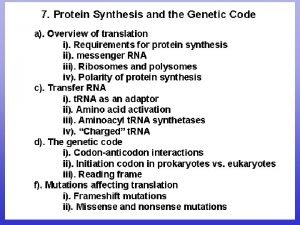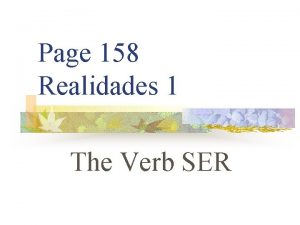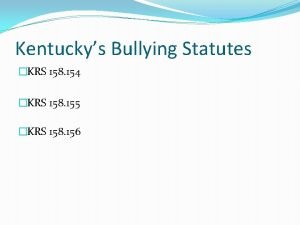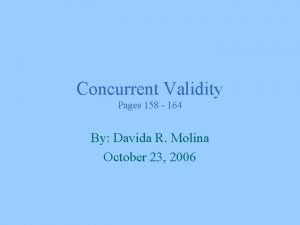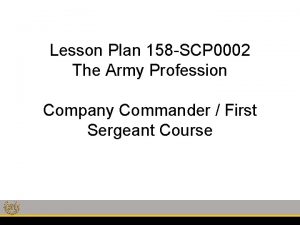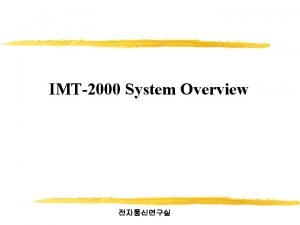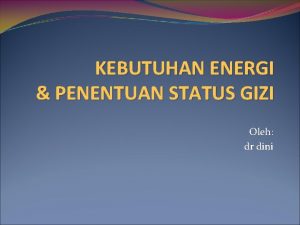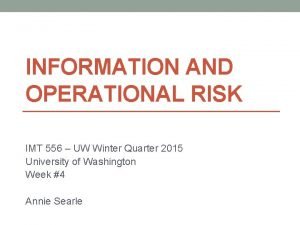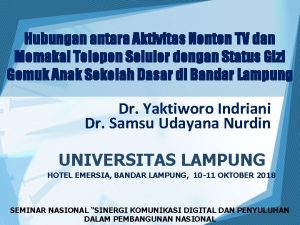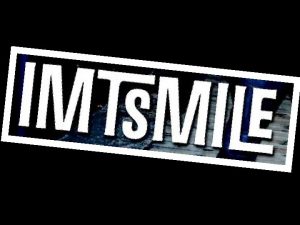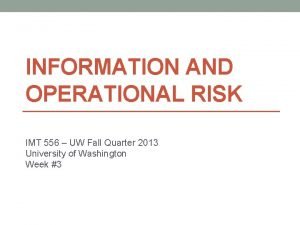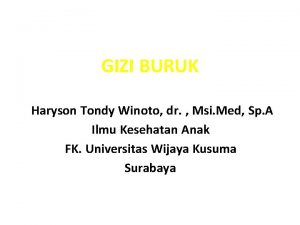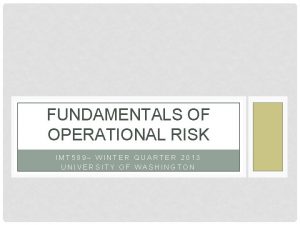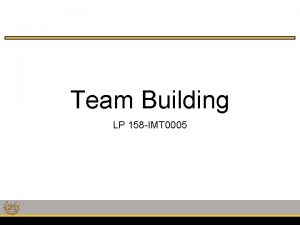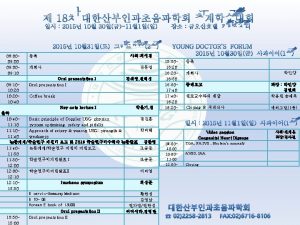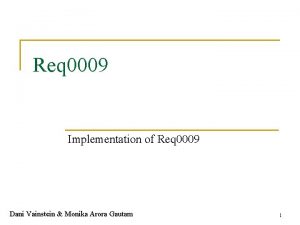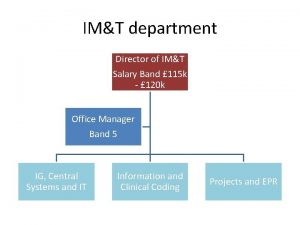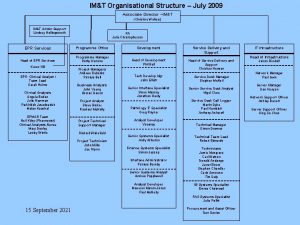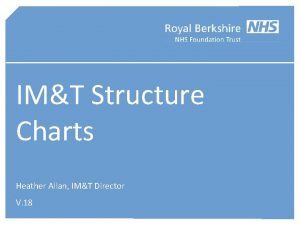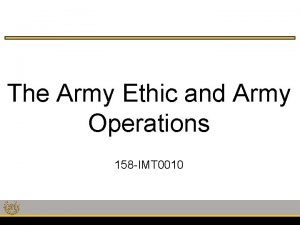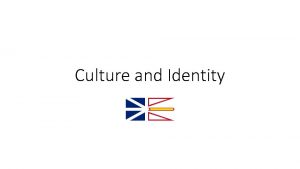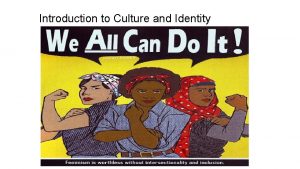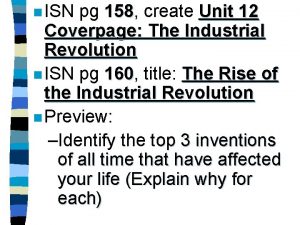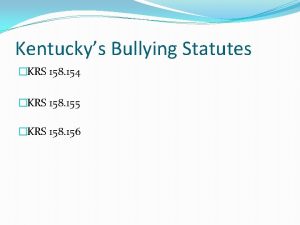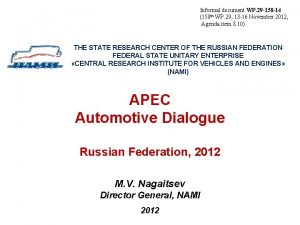Identity Climate and Culture 158 IMT 0009 Terminal




















- Slides: 20

Identity, Climate, and Culture 158 -IMT 0009

Terminal Learning Objective (TLO) Action: Review the relationship between identity, climate, and culture. Condition: In a classroom environment given access to ADP 6 -22, experiential learning activities, readings and doctrinal references, discussion with peers and facilitator feedback, and reflection time. Standard: • Define identity. • Contrast climate and culture. • Identify all three levels of Army leadership. • Explain the Army’s Framework for Character Development (AFCD) in a clear and concise manner. • Identify at least ten indicators of a positive climate. Learning Domain: Cognitive Level of Learning: Understand

Identity Video

Army Ethic The Army Ethic is the set of enduring moral principles, values, beliefs, and laws that guide the Army Profession and create the culture of trust essential to Army professionals in the conduct of missions, performance of duty, and all aspects of life (ADP 6 -22 para 1 -44). • The Army Ethic provides our legal and moral foundations. • By our Oath of Service, we commit ourselves to living the Army Ethic. • The essence of the Army Ethic is captured in our creeds, ethos, and the Army Values.

Identity Trusted Army professionals embrace a shared identity. • They defend the Constitution. • They are competent professionals. • They are committed and accountable to each other, the profession, and the American people.

Climate Characteristics of climate: • Short-term experience • Reflects how people think and feel • Depends on individual personality • Changes over time Positive climates result in teams that work together and respect each other. ADP 6 -22 para 6 -23

Culture consists of: • Shared attitudes • Values • Goals • Practices that characterize the institution The Army’s culture is deeply rooted in tradition. ADP 6 -22 para 6 -20 to 6 -22

Climate and Culture Comparison How we do things. How members feel about the unit Deeply embedded and enduring. Can be changed quickly Long held beliefs and customs Culture VS Climate Short term Shared attitudes, values, goals, and practices of the larger profession Shared perceptions and attitudes of the unit, often driven by observed policies and practices reflecting the leaders character The environment of the Army as a profession The environment of the unit

Healthy Culture and Climate Healthy cultures and climates share these characteristics: • Fosters unity, cohesion, and trust • Promotes and rewards mental agility • Rewards members who demonstrate the ability • Requires and rewards delegation of authority • Selects and rewards leaders who provide clear priorities • Is one of inclusion that demands diversity ADP 6 -22 para 6 -24

Levels of Leadership • Strategic • Organizational • Direct ADP 6 -22 Figure 1 -5

Direct Leadership Definition • First-line leaders • Develops subordinates by coaching, counseling, mentoring, and setting the example • Focused on short-range problems and immediate tasks ADP 6 -22 para 1 -124 to 1 -127

Organizational Leadership Definition • Exercises leadership through subordinate leaders • Establishes a climate that supports and empowers subordinate leaders • Focused on long-term organizational objectives ADP 6 -22 para 1 -128 to 1 -129

Strategic Leadership Definition • Guides and integrates multiple organizational level units • Influences several thousand to hundreds of thousands of people ADP 6 -22 para 1 -130 to 1 -132

Character Development Video

The Army Framework for Character Development Individual Army as. Organizations an Institution Identity Climate Culture Uphold the Army Ethic Self-Development Education Recruiting Lifelong Learning Training Policies-Regulations Coach-Counsel-Mentor Experience Concepts-Doctrine Ready & Resilient Certification Programs-Systems Soldier for Life Readiness Force Structure Mission Infrastructure Budget Direct Leader – Follower Organizational Leader Strategic Responsibilities

Successful Organizational Climates • A clear, widely known purpose (mission) • Well trained, confident Soldiers and Army Civilians • Disciplined, cohesive teams • Trusted, competent leaders • Promotes the Army Values and fosters the Warrior Ethos • Encourages learning, promotes creativity and performance • Recognizes mistakes as opportunities to learn • Values honest feedback ADP 6 -22 para. 9 -19

Indicators of Professional Climates • • • Leaders set clear priorities and achievable goals. There is a fair system of recognition, reward, and punishment. Leaders have the courage to admit when they are wrong. Leaders actively seek input from subordinates. Leaders have the authority to make decisions that are consistent with commander’s intent or guidance. Leaders lead by example and serve as good role models. Leader behavior is consistent with the Army Values and Ethic. Leaders lead from the front, sharing hardship. There is open, candid communications and information sharing. FM 6 -22 Chapter 7

Ethical Climate Assessment Survey (ECAS) The ethical climate of an organization is determined by: • Individual character of unit members • Policies and practices within the organization • Actions of unit leaders • Environmental and mission factors

Questions

CAPL Training and Education Resources
 Terminal and non terminal in compiler design
Terminal and non terminal in compiler design Riley day syndrome
Riley day syndrome The verb ser (p. 158) answers
The verb ser (p. 158) answers Krs 158
Krs 158 The verb estar (p. 107)
The verb estar (p. 107) Concurrent validity
Concurrent validity Scp-0002
Scp-0002 Cs 158
Cs 158 Cdma 2000 architecture
Cdma 2000 architecture Climate change 2014 mitigation of climate change
Climate change 2014 mitigation of climate change Tabel bmr
Tabel bmr Acat imt
Acat imt Imt 556
Imt 556 Imt status gizi
Imt status gizi Imt smile diskografia
Imt smile diskografia Min imt
Min imt Group 2 specialties
Group 2 specialties Imt 556
Imt 556 Imt structure
Imt structure Rumus imt ibu hamil
Rumus imt ibu hamil Imt 589
Imt 589

